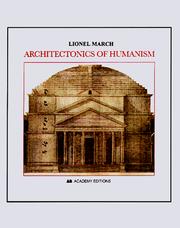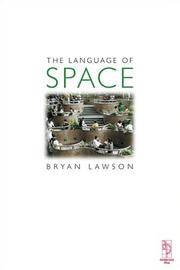| Listing 1 - 10 of 29 | << page >> |
Sort by
|
Book
ISBN: 3921729300 9783921729304 Year: 1989 Publisher: Bensheim Werner Pöhlert
Abstract | Keywords | Export | Availability | Bookmark
 Loading...
Loading...Choose an application
- Reference Manager
- EndNote
- RefWorks (Direct export to RefWorks)
muziektheorie --- Music --- harmonieleer --- harmonie --- Harmony --- Harmony. --- Improvisation (Music) --- 78.63 --- Harmonie --- Muziektheorie --- Improvisaties --- Duitsland --- 20e eeuw
Book
ISBN: 9062753000 Year: 1987 Publisher: Delft Delftse Universitaire Pers
Abstract | Keywords | Export | Availability | Bookmark
 Loading...
Loading...Choose an application
- Reference Manager
- EndNote
- RefWorks (Direct export to RefWorks)
72.01 --- Architectuurtheorie ; vormanalyse ; vormleer --- 72.013 --- Architectuur (theorie) --- Architectuurtheorie --- Architectuur ; proportie, symmetrie, harmonie --- Architecture
Book
ISBN: 9789057649936 Year: 2009 Publisher: Kerkdriel Librero
Abstract | Keywords | Export | Availability | Bookmark
 Loading...
Loading...Choose an application
- Reference Manager
- EndNote
- RefWorks (Direct export to RefWorks)
dr.
golden section --- Aesthetics of art --- mathematics --- wiskunde --- Mathematics --- Philosophy of nature --- natuur --- verhoudingen (kunst) --- proportion --- Nature --- gulden snede --- Gulden snede --- #gsdbA --- Proportieleer ; gulden snede ; gulden getal --- 7.013 --- 72.013 --- Kunst ; verhouding, vorm, ritme --- Architectuur ; proportie, symmetrie, harmonie
Book
ISBN: 9781138063464 1138063460 9781315161037 9781351664172 Year: 2018 Publisher: New York Routledge
Abstract | Keywords | Export | Availability | Bookmark
 Loading...
Loading...Choose an application
- Reference Manager
- EndNote
- RefWorks (Direct export to RefWorks)
This is the first volume to explore the reception of the Pythagorean doctrine of cosmic harmony within a variety of contexts, ranging chronologically from Plato to 18th-century England. This original collection of essays engages with contemporary debates concerning the relationship between music, philosophy, and science, and challenges the view that Renaissance discussions on cosmic harmony are either mere repetitions of ancient music theory or pre-figurations of the ‘Scientific Revolution’. Utilizing this interdisciplinary approach, Renaissance Conceptions of Cosmic Harmony offers a new perspective on the reception of an important classical theme in various cultural, sequential and geographical contexts, underlying the continuities and changes between Antiquity, the Middle Ages and the Renaissance. This project will be of particular interest within these emerging disciplines as they continue to explore the ideological significance of the various ways in which we appropriate the past
Music --- Harmony of the spheres --- Philosophy and aesthetics --- Harmony of the spheres. --- Philosophy, Renaissance. --- Philosophy and aesthetics. --- Pythagoras --- Influence. --- Musique --- Harmonie cosmique --- Philosophie de la Renaissance --- Philosophie et esthétique --- Aesthetics --- Music - Philosophy and aesthetics
Book
ISBN: 0855275545 9780855275549 Year: 1979 Volume: 9 Publisher: Hassocks : Harvester Wheatsheaf,
Abstract | Keywords | Export | Availability | Bookmark
 Loading...
Loading...Choose an application
- Reference Manager
- EndNote
- RefWorks (Direct export to RefWorks)
Logic --- Philosophy of nature --- History of civilization --- anno 1400-1499 --- anno 1500-1799 --- creativity --- Renaissance --- Architecture --- Psychology --- anno 1300-1399 --- anno 1500-1599 --- Europe --- Analogy --- Analogie --- Philosophy, Renaissance. --- Renaissance. --- Harmony (Aesthetics) --- Nature. --- Analogy. --- Intellectual life. --- Harmony (Aesthetics). --- Harmonie --- Vie intellectuelle --- 15e-16e siecles --- 16e-17e siecles

ISBN: 0471977543 Year: 1998 Publisher: London Academy Editions
Abstract | Keywords | Export | Availability | Bookmark
 Loading...
Loading...Choose an application
- Reference Manager
- EndNote
- RefWorks (Direct export to RefWorks)
golden section --- architectural theory --- gulden snede --- verhoudingen (kunst) --- Architecture --- proportion --- architectuurtheorie --- anno 1400-1499 --- anno 1500-1599 --- Architectuurtheorie ; humanisme ; verhoudingen --- Architectuur & getal ; Renaissance --- 72.013 --- Architectuur ; proportie, symmetrie, harmonie --- Composition, proportion, etc. --- Proportion (Architecture) --- Architectural design --- Composition (Art) --- Composition, proportion, etc --- Proportion

ISBN: 0750652462 Year: 2001 Publisher: Oxford Architectural Press
Abstract | Keywords | Export | Availability | Bookmark
 Loading...
Loading...Choose an application
- Reference Manager
- EndNote
- RefWorks (Direct export to RefWorks)
architectuur --- architecture [discipline] --- public spaces --- Architecture --- openbare ruimte --- Spatial behavior. --- Space perception. --- Space and time. --- Space frame structures --- Space (Architecture) --- Comportement spatial --- Perception spatiale --- Espace et temps --- Structures spatiales --- Espace (Architecture) --- Architecturale ruimte ; psychologische en sociale impact --- 72.013 --- Architectuur ; proportie, symmetrie, harmonie
Book
ISBN: 9068683217 Year: 2002 Publisher: Bussum : Thoth Publishers,
Abstract | Keywords | Export | Availability | Bookmark
 Loading...
Loading...Choose an application
- Reference Manager
- EndNote
- RefWorks (Direct export to RefWorks)
Drawing --- Environmental planning --- Architecture --- 72.012/013 --- 72.01 --- 72.02 --- Architectuurtheorie ; ontwerp ; compositie --- 72.013 --- Architectonisch ontwerp --- Architectuurontwerp --- Compositie (architectuur) --- Ontwerp (architectuur) --- Proportie (architectuur) --- Architectuuresthetica --- Architectuur (esthetica) --- Architectuurtekenen --- Ontwerp (techniek) --- Ontwerptechniek --- Architectuur ; proportie, symmetrie, harmonie --- Architectural design --- Proportion (Architecture) --- Composition (Art) --- Design --- Structural design --- Research --- Composition, proportion, etc --- Proportion --- architecture [discipline]
Book
ISBN: 026213246X Year: 1994 Publisher: Cambridge (MA) : M.I.T. Press,
Abstract | Keywords | Export | Availability | Bookmark
 Loading...
Loading...Choose an application
- Reference Manager
- EndNote
- RefWorks (Direct export to RefWorks)
Robert Mark plumbs the mystery of the great buildings of ancient Rome, the High Gothic era, and the Renaissance, revealing the astonishing depth of knowledge the ancient builders possessed. His findings provide a stronger technological focus for architectural history and a basis for more rational criticism of contemporary design. The Sydney Opera House, with its vast cost overruns and its years of delay, is a glaring example of misbegotten notions of structural honesty. MIT's Kresge Auditorium was conceived for visual effect without regard for technological flaws that arose from the misapplied criteria of form-follows function and forced its closing for more than a year. And in the building of Boston's John Hancock Tower, structural imperatives, were literally thrown to the winds. These are just a few of the eases in which the role of technology in the design of a large scale building has been either neglected or confused. In this book Robert Mark shows how an understanding of the technology of historical architecture can illuminate, even help eliminate, such costly misconceptions. Mark focuses on three eras - ancient Rome, the era of structural experimentation in High Gothic architecture, and the time of the great Renaissance domes - that have had lasting impacts on architectural planning. He makes full use of sophisticated computer modeling to gain new insights into early design methods insights that allow him to reinterpret technological precedents that are often misunderstood in contemporary architecture. Mark's provocative findings provide a stronger technological focus for architectural history and a basis for more rational criticism of contemporary design.
Architectuurtheorie ; proportie ; compositie ; harmonie --- Architectuur & technologie ; Rome ; Gothiek en Renaissance --- Architectuur ; techniek, werkmethoden, behoud --- Architectuur ; theorie, filosofie, esthetica --- Engineering sciences. Technology --- architecture [discipline] --- structural engineering --- Architecture --- Structural engineering. --- Technological innovations. --- Composition, proportion, etc. --- Architectuur en ingenieurswetenschappen --- 72.02 --- 72.01 --- 72.03 --- Architectuurtheorie --- Architectuur (theorie) --- Architectuurgeschiedenis --- Génie civil --- Génie civil --- Histoire (discipline) --- technologische innovatie
Book
ISBN: 9070157810 Year: 1989 Publisher: Maastricht Wetenschappelijke bibliotheek
Abstract | Keywords | Export | Availability | Bookmark
 Loading...
Loading...Choose an application
- Reference Manager
- EndNote
- RefWorks (Direct export to RefWorks)
Wiskunde geschiedenis --- Wiskunde : maatschappelijke relevantie --- 511 --- 510 --- 51-73 --- Architectuur ; in de natuur ; zuinigheidsbeginsel --- Architectuur en wiskunde ; architectuur en wetenschap --- Wiskunde ; variatierekening ; optimale vormberekening --- Mathematics--?-73 --- Architectuur ; proportie, symmetrie, harmonie --- Architectonische vormgeving --- Natuurlijke vormen --- out of print --- Architectonische vormgeving. --- Natuurlijke vormen. --- 51-73 Mathematics--?-73 --- Wiskunde ; geschiedenis --- natuur --- structuren --- 53 --- 54 --- $?$90/05 --- 72.013 --- Nature protection --- Science --- Mathematics
| Listing 1 - 10 of 29 | << page >> |
Sort by
|

 Search
Search Feedback
Feedback About
About Help
Help News
News